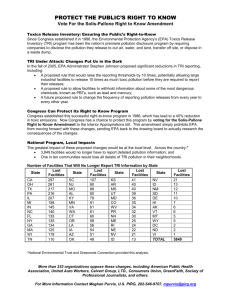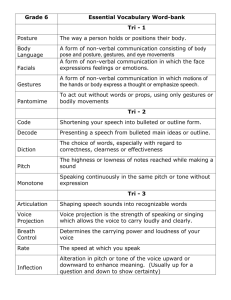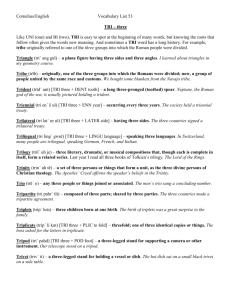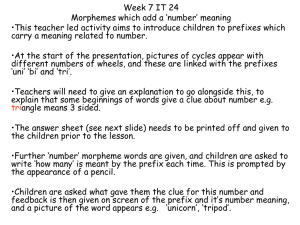Toxic Release Inventory
advertisement
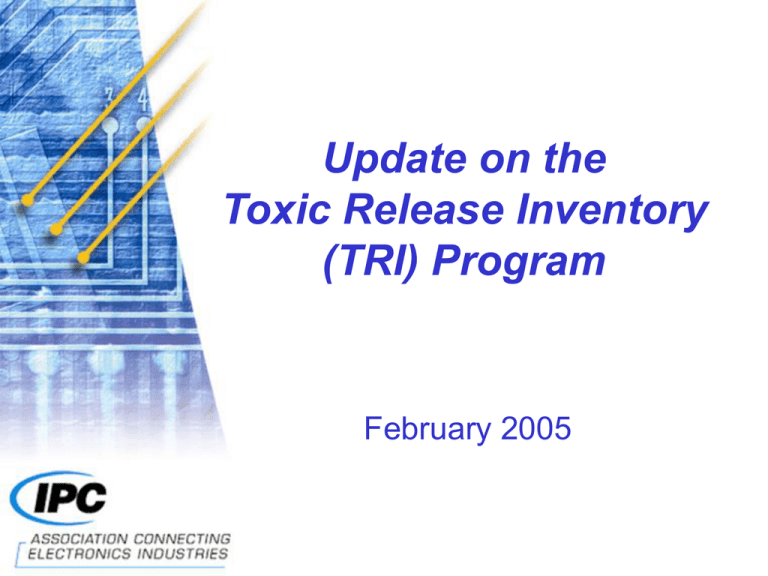
Update on the Toxic Release Inventory (TRI) Program February 2005 TRI National Meeting • February 8-10, 2005 • Included EPA, states, industry, • and environmental groups Hosted by Environmental Council of the States (ECOS) State Priorities (as Reported by ECOS) 1. 2. 3. 4. 5. Funding Partnerships Oversight Information Management Previous weakening of Environmental Regulations TRI Data Use • • • • EPA emphasis on collection of quality data EPA not responsible for data use OPPTS Risk Screening for Environmental Indicators (RSEI) Air and water risk screening based on lbs. of TRI substances Regional Offices Enforcement targeting Waste minimization programs TRI Data Use (Con’t) • Alarming use of data by RCRA office Regulatory Development/ Options Prioritization ID potential NPEP (National Partnership for Environmental Priorities) partners Identify P2/Waste Min. Opportunities Track GPRA progress Use of TRI data is limited because it does not contain life-cycle data TRI Data Quality/ Consistency • • • • Recent addendum/corrections to ’98 Q&A Monthly conference calls between regions to informally resolve differing interpretations Discussion/request of FACA on guidance Particular interest in Section (VIII) definitions TRI Reports: eFDR • Discussion of pros/cons • Why can’t EPA make available • in database form? Environmental groups planning to “vacuum up” eFDR to make available in database form TRI in Context • • Background Chemicals in the Economy TRI History TRI v. Hazards Macro Trends Overall releases decreasing over time What is causing this? Economic performance (shrinking economy/ overseas production) P2/ Waste minimization/Raw material substitution Good housekeeping • Non-TRI Releases and Transfers • Chemicals, sectors, sources not covered by TRI Facilities below TRI reporting thresholds Trends in Waste Management TRI in Context (Con’t) • • • Sector Oriented View of TRI Reporting/Releases Extractive Manufacturing Utilities and Supporting Industries Waste Disposal Geographic Distribution TRI Chemicals of Interest Trends in Releases Factors Contributing to Trends EPA Activities Likely Chemicals Profiled: Lead Dioxins Mercury TCE Toluene EPA’s TRI Modernization Goals • • • • • • • Raise data quality Data registries Online real-time algorithms Control cost of data input and correction Increase the ability to integrate TRI data with other sources Increase the ability to analyze TRI data Speedup dissemination of data Reduce the burden on TRI reporters Meet the President’s management agenda/EGov initiative Web Enabled TRI-ME Benefits (According to EPA) • • • • • • • Facilities will come to one spot for all their EPA business Facility will no longer have to download and install software Facilities no longer will have to maintain data on their PC Facility data can be pre-populated Users can enter data in one sitting (or period) and then be done with TRI for the year Might eliminate or significantly reduce data revisions by providing immediate feedback TRI-ME can become “smarter,” guiding users through the data submission process to make it easier and faster Phase I Burden Reduction • Comments due March 11, 2005 • Estimated burden reductions are suspect • Minor changes Eliminates latitude/longitude Eliminates EPA program identification numbers (4.9 and 4.10) Eliminates ‘Percentage of Total Quantity of Toxic Chemicals Contributed by Stormwater (5.3 C) Streamlines code list for On-Site Waste Treatment Methods Eliminates ‘Range of Influent Concentration’ Allows reporting of waste treatment efficiency as a range instead of exact percentage Streamlines on-site recycling process codes Phase II Burden Reduction • EPA December 2003 white paper discussed 6 options: Higher reporting thresholds for small businesses Higher reporting thresholds for a category of facilities or class of chemicals with small reportable amounts Expanding eligibility for the Form A Certification Statement Creating a new, "No Significant Change" Certification Statement Use of range reporting for Section 8 of the Form R Other Options for burden reduction Relief for facilities reporting zero releases on their Form R reports Alternate year reporting Phase II Burden Reduction (Cont.) • Converging on four options to be presented to Senior Management • Will include Form NS (No Significant Change) August Proposal? Metals Framework • ORD document undergoing SAB review • Final product may suggest need to • reconsider previous PBT decisions relating to lead and other metals While review could affect PBT status, could also have no impact once individual compound toxicity considered (e.g. recent NCI determination) Other Miscellaneous • Current ICR expires January ’06 Proposal likely in March Expect to include very detailed burden analysis to facilitate evaluation of burden reduction • • NAICS rule late spring; not effective until RY ’05 RY ’04 forms coming out in March April mailing
